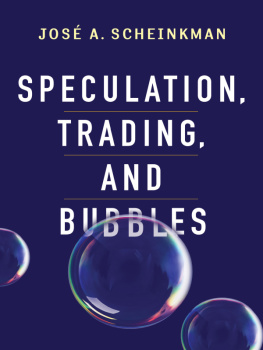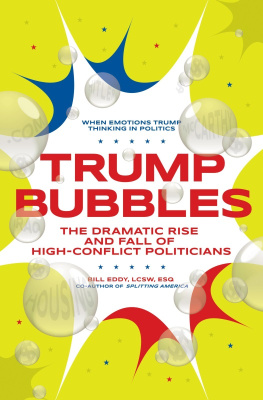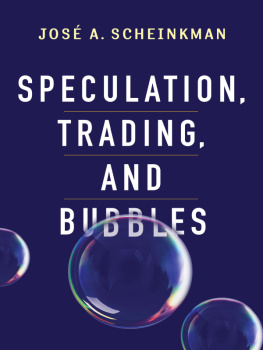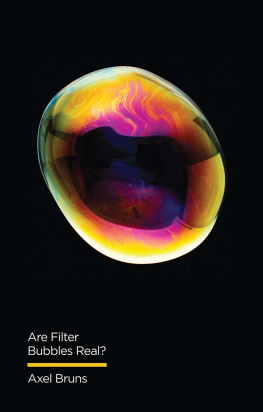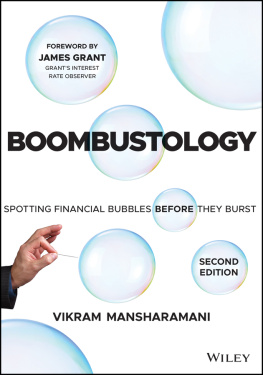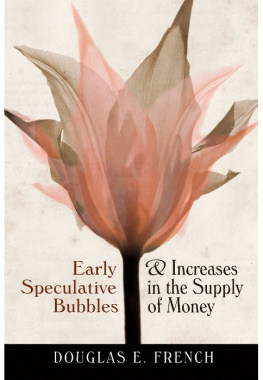SPECULATION, TRADING, AND BUBBLES
KENNETH J. ARROW LECTURE SERIES
KENNETH J. ARROW LECTURE SERIES
Kenneth J. Arrows work has shaped the course of economics for the past sixty years so deeply that, in a sense, every modern economist is his student. His ideas, style of research, and breadth of vision have been a model for generations of the boldest, most creative, and most innovative economists. His work has yielded such seminal theorems as general equilibrium, social choice, and endogenous growth, proving that simple ideas have profound effects. The Kenneth J. Arrow Lecture Series highlights economists, from Nobel laureates to groundbreaking younger scholars, whose work builds on Arrows scholarship as well as his innovative spirit. The books in the series are an expansion of the lectures that are held in Arrows honor at Columbia University.
Creating a Learning Society: A New Approach to Growth, Development, and Social Progress, Joseph E. Stiglitz and Bruce C. Greenwald
The Arrow Impossibility Theorem, Eric Maskin and Amartya Sen
SPECULATION, TRADING, AND BUBBLES
JOS A. SCHEINKMAN
WITH
KENNETH J. ARROW,
PATRICK BOLTON,
SANFORD J. GROSSMAN,
AND JOSEPH E. STIGLITZ
COLUMBIA UNIVERSITY PRESS | NEW YORK
Columbia University Press
Publishers Since 1893
New York Chichester, West Sussex
cup.columbia.edu
Copyright 2014 Columbia University Press
All rights reserved
E-ISBN 978-0-231-53763-6
Library of Congress Cataloging-in-Publication Data
Scheinkman, Jos Alexandre.
Speculation, trading, and bubbles / Jos A. Scheinkman, with Kenneth J. Arrow, Patrick Bolton, Sanford J. Grossman, and Joseph E. Stiglitz.
pages cm. (Kenneth J. Arrow lecture series)
Includes bibliographical references and index.
ISBN 978-0-231-15902-9 (cloth : alk. paper) ISBN 978-0-231-53763-6 (ebook)
1. SpeculationHistory. 2. InvestmentsHistory. 3. Capital marketHistory. 4. StocksPricesHistory. I. Title.
HG6005.S34 2014
332.64'5dc23
2014006646
A Columbia University Press E-book.
CUP would be pleased to hear about your reading experience with this e-book at .
Cover design: Noah Arlow
References to websites (URLs) were accurate at the time of writing. Neither the author nor Columbia University Press is responsible for URLs that may have expired or changed since the manuscript was prepared.
CONTENTS
by Kenneth J. Arrow
by Joseph E. Stiglitz
JOSEPH E. STIGLITZ
JOS A. SCHEINKMAN
PATRICK BOLTON
SANFORD J. GROSSMAN
KENNETH J. ARROW
KENNETH J. ARROW
I want to briefly express my gratitude for the existence of this series of lectures in my honor and to mark briefly the continuities and discontinuities in economics at Columbia.
Columbia was a very chaotic place when I was here. The departments were teaching different courses that had very little relation to each other. I came in really to study statistics, not to study economics. There was no degree in statistics, so I took my Ph.D. in economics simply as the only way of getting close to it. I got hooked. My mentor was somebody whose influence is still felt today, Harold Hotelling. I took his course in economics, which was totally different because nobody was teaching optimization, classic principles, or equilibrium; these subjects that were on the whole not taught. In fact, there was no course in price theory required of economics graduate students.
The leading people during this time were interested in business cycles, a term that is a little archaic now. Although that term is little used today, the ups and downs are still with us. The great man in that field was Wesley Clair Mitchell, a name that may mean very little to you, but he was the founder of the National Bureau of Economic Research. He was on leave in the year I was taking most of my courses, so he had a substitute, his deputy, Arthur F. Burns, who was a professor at Rutgers and who later became the chairman of the Federal Reserve and chairman of the Council of Economic Advisors. Burns was a very brilliant person, although I think he has had very little influence because he was very self-critical, and never really finished very much. But he was one of the brightest people I ever met, although his philosophy could not have been more opposed to mine. Even as a statistician, I wanted a formal model, and the models that I was attracted to were anything but. Many were based on the fact that the economy fluctuated a great deal. In retrospect, I am a little surprised that the financial side, which this volume discusses, did not play a role, considering all the ups and downs in the iron and steel industry. But all industries looked more or less alike to these people. As a statistician I did not want to be too critical, because the one thing that they were motivated to do was collect a lot of data, which I assumed the more formal econometricians would be then able to use, so one didnt want to discourage this activity.
The department, of course, has gone through so many changes; even after I returned after World War II, it was different. Albert Jay Nock very much emphasized imperfections in the credit market. He was the biggest figure in the postwar period. He and I respected each other a great deal. He was very encouraging to me even though he was going in a somewhat different direction. The subsequent history of the Economics Department has shown that it has continued, and perhaps even with increased vitality. The training of graduate students of economics at Columbia University and elsewhere is much more stringent and demanding than it was in my day. There is hardly any comparison. I want to welcome Jos Scheinkman to continue this tradition.
T he Kenneth J. Arrow Lecture Series has been made possible through the efforts of Columbia Universitys Committee on Global Thought (which I chaired when this series was inaugurated, and which is now co-chaired by Saskia Sassen) and by the Program in Economic Research (PER) of the Department of Economics at Columbia University (chaired by Michael Woodford at the time of this lecture) with the support and encouragement of the Columbia University Press.
We are especially indebted to Robin Stephenson and Sasha de Vogel of the Committee on Global Thought, and Myles Thompson and Bridget Flannery-McCoy of the Press for guiding this series to publication. We also thank Ryan Rivera and Laurence Wilse-Samson for their assistance with this volume.
Joseph E. Stiglitz
JOSEPH E. STIGLITZ
K enneth Arrow is one of Columbias most distinguished graduates, whose accomplishments I hope all our graduate students seek to emulate. In this series, we have organized an annual lecture each around one of his papers or contributions. The lectures and subsequent discussions highlight the ideas that have been developed in subsequent decades elaborating on his original thoughts.
The first lecture, by Bruce Greenwald and me (with Philippe Aghion, Robert Solow, and Kenneth Arrow as discussants) was based on a paper Ken wrote in 1962 on learning by doing, which has been one of the most innovative papers in the theory of technical change. Arrow had explained how knowledge is developed in the process of production. Bruce and I expanded on that idea to enquire into how one could create a society that was better at learninga society and an economy which would, accordingly, be more dynamic, with a faster pace of increases in standards of living. We developed that lecture into a book,

